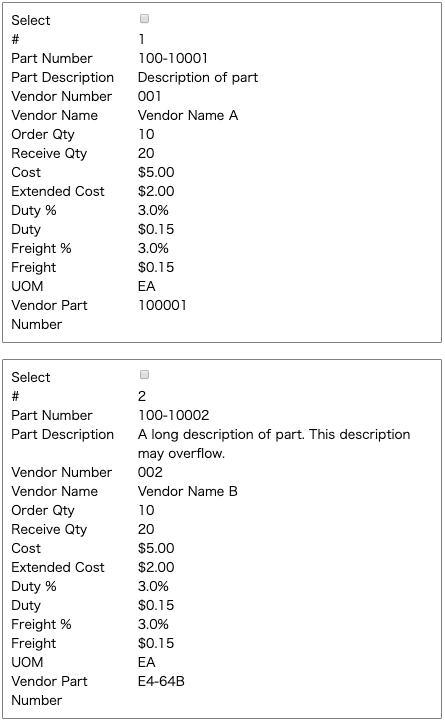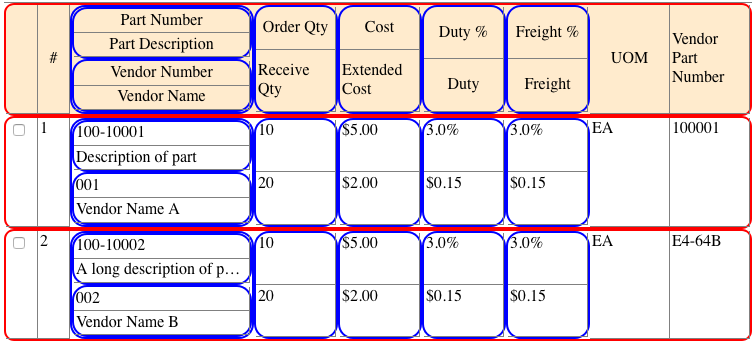Get Ready For Css Grid Layout Pdf Download

TL;DR
The most popular way to display a collection of similar data is to use tables, but HTML tables have the drawback of existence hard to make responsive.
In this article, I use CSS Grid Layout Module and CSS Properties (and no Javascript) to layout tables that wrap columns depending on screen width, which further changes to a card based on layout for small screens.
For the impatient, look at the following pen for a prototypical implementation.
A Little History of Responsive HTML Tables
Responsive tables aren't a new topic, and there are many solutions that have already been proposed. "Responsive Table Data Roundup" first published in 2012 by Chris Coyier, has things summarized very neatly (including a 2018 update).
"Really Responsive Tables using CSS3 Flexbox" past Vasan Subramanian shows an idea of wrapping columns, implemented with Flexbox.
Even though many interesting ideas have been proposed, libraries like bootstrap opt for horizontal scrolling for small screens.
As we at present accept CSS Grid, I think we could have a amend mutual alternative to horizontal scrolling.
HTML Tables
Starting with the basics, a tabular array in HTML is a layout format for displaying collections of items through a matrix of rows and columns. Items are laid out in rows, with the same data attributes in the same columns, with the rows oft sorted with one or more sortable attributes. The format gives you a birds-eye view to chop-chop grasp and examine large quantities of data.
For case, hither's a hypothetical tabular array of buy society details, that you may meet in a purchasing application.

An particular, in this case, is a purchase order detail, that has attributes such as part number, part clarification, etc.
When using HTML tables, the layout of the data is hardcoded every bit rows and columns (eastward.k. <tr> and <td>). This may exist sufficient for usage by a screen that fits the whole tabular array width, but in reality, this does not utilize for the myriad of devices that be today. In terms of hacks, you can alter the display property of tables and use whatever layout you can do with CSS in general, but that doesn't seem semantically correct.
Tables Redefined (= Collection of Items)
Let's starting time by redefining how table data should be expressed in HTML.
Equally stated earlier, since table data is essentially an ordered collection of items, information technology seems natural to utilise ordered lists. Also, since tables are ofttimes used to supplement textual descriptions, it seems natural to enclose this in a section, simply this would depend on the context of how the table data is being used.
<section> <ol> <!-- The beginning list particular is the header of the table --> <li> <div>#</div> <!-- Enclose semantically like attributes as a div bureaucracy --> <div> <div>Part Number</div> <div>Part Clarification</div> </div> ... </li> <!-- The rest of the items in the list are the actual data --> <li> <div>1</div> <!-- Group part related information--> <div> <div>100-10001</div> <div>Description of role</div> </div> ... </li> ... </ol> </section> Vanilla <div>'s are used to express particular attributes since HTML5 does non ascertain an appropriate tag for this. The central hither is to express semantically similar attributes as a hierarchy of <div>'s. This structure will be used when defining how the data should exist laid out. I will come up dorsum to this in the next section on the topic of styling.
As for the actual information within the <div> chemical element, the first item in the list is the header, and the remainder of the items are the actual data.
At present, it's time to first talking near styling the items with CSS Grid.
Styling Item Collections
The bones idea here is to display all attributes of the item as a normal table, display width permitting. This layout has the luxury of being able to see every bit many items (rows) as possible.

When the width of the brandish becomes narrower, some attributes are stacked vertically, in lodge to save horizontal infinite. The choice of stacking attributes should be based on:
- Exercise the attributes make sense when stacked vertically? and,
- When stacked vertically, does information technology save horizontal space?





When the width further shrinks to the size of a mobile device, each item is displayed as a bill of fare. This layout has redundancy because the attribute names are repeatedly displayed on each menu, and has the to the lowest degree glanceability, only does not compromise usability (e.grand. horizontal scrolling, super small text, etc).


Now let's swoop into the details.
Styling Step ane: Total Table
Here's a visual summary of how things will be implemented with CSS Grid.

In guild to make columns wrap, multiple grid containers are defined every bit a hierarchy. The red box is a grid container for each row, and the blue box is a container for each column group that wraps.
Let' s start past setting the list as a grid container by defining a class called .detail-container and applying it to the <li>(the crimson box).
.particular-container { display: grid; filigree-template-columns: 2em 2em 10fr 2fr 2fr 2fr 2fr 5em 5em; } The number of explicit columns specified with grid-template-columns is nine, which is the number of top-level <div>'south, directly under <li>.
The cavalcade'southward width is defined in relative length to make the columns wrap. The actual fraction has to be fine-tuned, based on the content.
The columns that don't wrap are defined in accented length to maximize width usage for the wrapping columns. In the purchase club details example, the second column is a two-digit Id, and so I set the width to double that size of 2 g'southward.
Next, we define another filigree container called .attribute-container and apply it on all intermediate <div>'s under the list (the blue box).
.aspect-container { display: grid; grid-template-columns: echo(machine-fit, minmax(var(--column-width-min), 1fr)); } The minimum column width for all grid items nether .attribute-container is specified with a CSS variable called --column-width-min(more on this subsequently) using the minmax function, with the maximum set up to take the rest of the space (eastward.g. ane fraction). Since grid-template-columns are repeated, available horizontal infinite will be carve up into the maximum number of columns that could have at least --column-width-min, and the residuum of the columns would get to the next line. The cavalcade's width will be stretched if there is backlog horizontal space because the repeat is auto-fited.
Styling Step ii: Wrapping Table
Next, --column-width-min needs to be specified independently for each column in order to wrap. Simply to be clear, the variables demand to be specified in lodge for the full table to render properly as well. To do this, a grade is set for each .attribute-container, and a different --column-width-min is specified for each class scope.
Let's accept a await at the HTML where .function-id is applied,
<div form="attribute-container office-id"> <div>Part Number</div> <div>Part Clarification</div> </div> and the CSS:
.part-id { --column-width-min: 10em; } This specific grid container will have two columns, as long as the available width is wider than 10em for each filigree item (e.1000. the grid container is wider than 20em). Once the grid container's width becomes narrower than 20em, the 2d grid item volition get to the next row.
When we combine CSS properties similar this, we need only one filigree container .aspect-container, with the details changing where the course is practical.
We can further nest .aspect-containersouthward, to accept multiple levels of wrapping with different widths, every bit in the following exert.
<div class="attribute-container part-information"> <div class="attribute-container part-id"> <div grade="attribute" data-name="Part Number">Part Number</div> <div class="attribute" information-proper name="Function Description">Part Description </div> </div> <div form="attribute-container vendor-information"> <div class="aspect">Vendor Number</div> <div class="attribute">Vendor Name</div> </div> </div> .part-information { --cavalcade-width-min: 10em; } .function-id { --column-width-min: 10em; } .vendor-data { --column-width-min: 8em; } All of the above is enclosed in the following media query. The bodily breakpoint should be selected based on the width necessary when your table is wrapped to the extreme.
@media screen and (min-width: 737px) { ... } Styling Footstep Three: Bill of fare Layout
The card layout will await like a typical form with aspect names in the first column and aspect values in the second cavalcade.
To practice this, a course chosen .aspect is defined and applied to all foliage <div> tags nether the <li>.
.attribute { display: grid; filigree-template-columns: minmax(9em, thirty%) 1fr; } The aspect names are taken from a custom aspect of the leaf<div> called data-name, for example <div grade="attribute" data-name="Part Number">, and a pseudo-chemical element is created. The pseudo-element volition be subject area to the grid container's layout.
.attribute::before { content: attr(information-name); } The offset particular in the list is the header and does not need to be displayed.
/* Don't display the offset particular, since it is used to display the header for tabular layouts*/ .collection-container>li:first-kid { display: none; } And finally, the cards are laid out in one cavalcade for mobile devices, but two for screens with a little bit more width, but not plenty for displaying a table.
/* 2 Column Carte du jour Layout */ @media screen and (max-width: 736px) { .collection-container { display: grid; grid-template-columns: 1fr 1fr; filigree-gap: 20px; } ... } /* i Cavalcade Card Layout */ @media screen and (max-width:580px) { .collection-container { display: grid; filigree-template-columns: 1fr; } } Finishing Notes
Accessibility is an area that wasn't considered at all and may take some infinite for improvement.
If y'all accept any ideas or 2d thoughts, delight feel free to comment!
And of form, thank you for reading.
Learn to code for gratuitous. freeCodeCamp's open source curriculum has helped more than 40,000 people get jobs as developers. Get started
DOWNLOAD HERE
Posted by: scateswasoness.blogspot.com

0 Comments